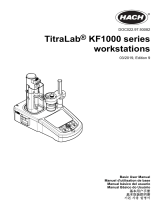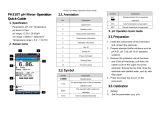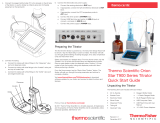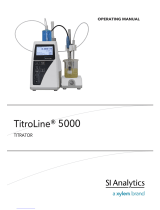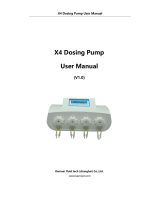Page is loading ...

1
Instruction Manual
HI 84532
TITRATABLE ACIDITY
MINITITRATOR & pH METER
for Fruit Juice
www.hannainst.com

2
Dear Customer,
Thank you for choosing a Hanna Instruments product.
Please read this instruction manual carefully before using this instrument. This manual will
provide you with the necessary information for correct use of the instrument, as well as a precise
idea of its versatility.
If you need additional technical information, do not hesitate to e-mail us at [email protected]
or view our worldwide contact list at www.hannainst.com.

3
All rights are reserved. Reproduction in whole or in part is prohibited without the written consent
of the copyright owner, Hanna Instruments Inc., Woonsocket, Rhode Island, 02895, USA.
TABLE OF CONTENTS
PRELIMINARY EXAMINATION................................................................................................. 4
GENERAL DESCRIPTION ........................................................................................................ 5
SPECIFICATIONS ................................................................................................................... 7
PRINCIPLE OF OPERATION .................................................................................................... 8
FUNCTIONAL DESCRIPTION................................................................................................... 9
TITRATOR STARTUP ........................................................................................................... 11
SETUP MENU .................................................................................................................... 12
GUIDE TO DISPLAY CODES ................................................................................................... 16
ELECTRODE PREPARATION .................................................................................................. 19
ELECTRODE CALIBRATION PROCEDURE ................................................................................. 20
pH BUFFER TEMPERATURE DEPENDENCE............................................................................ 24
DOSING PUMP INSTALLATION ............................................................................................. 25
DOSING PUMP PRIME PROCEDURE ..................................................................................... 25
PUMP CALIBRATION PROCEDURE ........................................................................................ 27
TITRATION PROCEDURE ..................................................................................................... 29
pH MEASUREMENT ............................................................................................................ 34
PC INTERFACE AND DATA TRANSFER ................................................................................... 38
TROUBLESHOOTING GUIDE ................................................................................................ 39
ELECTRODE CONDITIONING AND MAINTENANCE .................................................................. 41
ACCESSORIES ..................................................................................................................... 42
WARRANTY........................................................................................................................ 43

4
PRELIMINARY EXAMINATION
Please examine this product carefully. Make sure that the instrument is not damaged. If any
damage occurred during shipment, please notify your Dealer.
Each HI 84532 minititrator is supplied complete with:
• HI 84532-70 Reagent Kit for titratable acidity in fruit juice
• HI 1131B pH electrode
• HI 7662-T Temperature probe
• HI 7082 Electrode Fill Solution (30 mL)
• Two 100 mL beakers
• One 20 mL beaker
• Tube set (aspiration tube with titrant bottle cap and dispensing tube with tip)
• Dosing Pump Valve
• 5 mL Syringe
• 1 mL Plastic Pipette
• Stir bar
• Power adapter
• Instruction manual
Note: Save all packing material until you are sure that the instrument works correctly. Any
defective item must be returned in its original packing.

5
GENERAL DESCRIPTION
The HI 84532 is a low-cost, easy to use microprocessor-based automatic minititrator and pH meter
designed for the rapid and accurate analysis of Total Titratable Acidity in fruit juice. The HI 84532
minititrator is a valuable tool because of its ability to eliminate subjective factors including color
indicators, errors in mathematical calculations or erratic titrant additions from the measurement, it
will quickly become a valuable acidity analysis tool of fruit juice.
The instrument benefits from Hanna’s many years of experience as a manufacturer of quality
analytical instruments. A clear and well-designed user interface makes the instrument intuitive and
easy to use.
The instrument employs a powerful and effective built-in algorithm to analyze the pH response to
determine the exact endpoint, then uses this to perform the necessary calculations.
By pressing the Start key in Titrator mode, the instrument will automatically titrate the sample to
the end point. The results are immediately displayed in the selected unit, then the instrument is
ready for another titration by pressing the Restart key.
A dedicated HELP key aids in setup, calibration, status and troubleshooting.
Other features:
• pH meter / mV meter
• Stir speed control
• Graphic mode to display the titration data
• Data can be stored using the log feature and then exported to a USB stick or
transferred to a PC using the USB connection
• Log on demand for up to 400 samples (200 for mV/pH measurements; 200 for
titration results)
• GLP feature, to view calibration data for pH electrode and pump

6
The HI 84532 minititrator uses a method based on the Official Methods of Analysis of AOAC
International.
The fruit juice is titrated with sodium hydroxide until the pH end point at 8.1.
The end point is determined by the potentiometric input.
SIGNIFICANCE OF USE
Titratable acidity is an important parameter in determining fruit maturity. The HI 84532 measures
the concentration of titratable hydrogen ions contained in fruit juice samples, by neutralization with
a strong base solution to a fixed pH. This value includes all the substances of an acidic nature in the
fruit juice including: free hydrogen ions, organic acids and acid salts. Titratable acidity is expressed
as g/100 mL of the predominant acid.
The table below lists a variety of common fruit juices along with an approximate titratable acidity
range and predominant acid. This table is to be used as a reference only.
seciuj,stiurF
ytidicaelbatartiT
001/g( )Lm
dicatnanimoderP
raep,elppA 08.0-63.0 dicacilaM
yrrebnarC 6.3-6.1 dicacirtiC
tiurfeparG 0.2-2.1 dicacirtiC
nomeL 2.6-4 dicacirtiC
ognaM 48.0-43.0 dicacirtiC
egnarO 4.1-8.0 dicacirtiC
yrrehcteews,eniratcen,hcaeP 49.0-42.0 dicacirtiC
elppaeniP 6.1-7.0 dicacirtiC
yrrehcruoS/mulP 46.1-49.0 dicacilaM
yrrebwartS 1.1-6.0 dicacirtiC
epargelbaT 9.0-4.0 dicaciratraT
otamoT 00.1-43.0 dicacirtiC

7
SPECIFICATIONS
Titrator Range Low range: 5 mL sample
g/100 mL
as citric acid: 0.10 - 2.00 %CA
g/100 mL
as tartaric acid: 0.11 - 2.35 %TA
g/100 mL
as malic acid: 0.10 - 2.09 %MA
High range: 5 mL sample
g/100 mL
as citric acid: 1.00 - 10.00 %CA
g/100 mL
as tartaric acid: 1.17 - 11.72 %TA
g/100 mL
as malic acid: 1.05 - 10.47 %MA
Resolution 0.01%
Accuracy 3% of reading or ± 0.02 %CA @25 °C whichever is greater
Sample volume 5 mL
Titration method Acid-base titration
Principle End point titration: 8.1 pH
Pump speed 10 mL/min
Stirring speed 600 rpm
Log data Up to 200 samples
pH meter pH meter - 2.0 to 16.0 pH / - 2.00 to 16.00 pH
pH Resolution 0.1 pH / 0.01 pH
pH Accuracy ± 0.01 pH
pH Calibration 1, 2 or 3 calibration points;
4 available buffers (4.01, 7.01, 8.20, 10.01)
Temperature Manual or automatic
compensation
mV meter mV meter -2000.0 to 2000.0 mV
mV Resolution: 0.1 mV
mV Accuracy: ± 1.0 mV
Log data Up to 200 samples (pH or mV)
Temperature Range -20.0 to 120.0 °C (-4.0 to 248.0 °F)
Resolution 0.1 °C
Accuracy ±0.4 °C without probe error
Electrode HI 1131B
Temperature Probe HI 7662-T
Environment 0 to 50 °C (32 to 122 °F); max 95% RH non-condensing
Power supply 12 Vdc power adapter
Dimensions 235 x 200 x 150 mm (9.2 x 7.9 x 5.9”)
Weight 1.9 kg (67.0 oz.)

8
PRINCIPLE OF OPERATION
Fruit juice acidity is determined by neutralization of all available hydrogen ions present in the
sample, with a strong base solution:
H
+
+HO
-
H
2
O
In an ideal solution, the end point of an acid titration corresponds stoichiometrically to the complete
neutralization of the acids present.
The pH end point at 8.1 is automatically detected by the pH electrode. End point detection by
potentiometric method is more objective than the end point detection using color indicators. For
precise results, the sample volume, titrant volume and the titrant concentration must be known.
The HI 84532 minititrator is designed to determine the acidity of fruit juices. The titration is
displayed in % (g/100 mL) of the predominant acid (citric, malic or tartaric acid).
It is important to titrate fresh samples of fruit juice. For increased precision, keep the fruit juices in
capped vessels (avoid prolonged exposure to air). Also avoid refrigerating the juice, as significant
portion of the tartaric acid (ex. grapes juice) will precipitate out and the results obtained will be
lower then expected results.
To maintain the high accuracy of the mini titrator requires a simple pump calibration procedure.
The pump calibration involves the analysis of a known volume of a known solution. The instrument
will perform a differential analysis to compensate for changes in the dosing system. This procedure
should be performed daily.
REQUIRED REAGENTS
Code Description
HI 84532 - 50 Low Range Titrant
HI 84532 - 51 High Range Titrant
HI 84532 - 55 Calibration Standard

9
REAR VIEW
6) Temperature probe
7) pH Electrode
8) Electrode holder
9) Beaker
10) Power switch
11) USB connector (PC interface)
12) USB connector (Storage interface)
13) Power adapter
14) BNC electrode connector
15) Temperature connector
16) Reference connector
17) Titrant bottle
18) Syringe
19) Aspiration Tube
20) Dosing Pump Valve
FRONT VIEW
FUNCTIONAL DESCRIPTION
OVERHEAD VIEW
1) Titrant bottle
2) Liquid Crystal Display (LCD)
3) Keypad
4) Electrode holder
5) Dispensing tube

10
ESC - used to leave the current screen and to return either to the previous screen or to the
main screen. In Setup, exits a parameter without changing the value.
/
- used to modify the parameters’ values, to scroll the information displayed while
viewing a help screen or to move between the options from the instrument’s Setup
CAL - used to access the Electrode and Pump calibration options
HELP - used to access/exit the instrument’s contextual help
LOG - used to save the current mV/pH reading in pH meter mode and the titration result
MENU - used to enter Setup, Recall or GLP selection menu, while instrument is in pH or
Titration mode
STIR - used to start/stop the stirrer
Note: The stirrer starts automatically during pump calibration and titration, it cannot
be stopped by pressing STIR key.
GUIDE TO INDICATORS
During the instrument’s operation information is displayed on the LCD.
Displayed icons:
KEYPAD FUNCTION
1) Current time and instrument mode information (pH meter or Titrator)
2) pH electrode condition
3) Instrument status
4) Virtual option keys
Unstable reading.Stirrer on. Pump running.
Parameter can be modified.Stirrer is not working properly.

11
DOSING PUMP
The dosing pump is based on a valve that automatically moves the titrant between the titrant
bottle and syringe when filling the syringe and between the syringe and sample when
dispensing. A replaceable 5 mL plastic syringe is used to limit the amount of titrant used per test
to ensure the highest possible accuracy. Before a set of titrations, it is necessary to prime the
dosing system.
Note: Once titrations have been completed, the dosing system should be cleaned with deionized
water using the prime feature.
TITRATOR STARTUP
This is a general outline of the steps required to perform a titration. The following topics are
expanded upon in each section that follows.
• Place the instrument on a flat table. Do not place the instrument in direct sun light.
• Connect the power adapter to the instrument.
• Turn the instrument ON using the power switch on the rear panel of the instrument.
• Set up the instrument. See the “Setup Menu” section for details.
• Connect the pH electrode to the instrument.
• Connect the temperature probe to the instrument.
• Calibrate the pH electrode.
• Connect the tubes and the valve. See the “Dosing Pump Prime Procedure” section for the
procedure.
• Remove the titrant bottle cap and replace it with the bottle cap with tubes. Place the titrant
bottle in the appropriate place on the titrator top.
Note: Different titrants are required based on the concentration. See “Pump Calibration Procedure”
for details.
• Prime the syringe. To assure high accuracy, verify there are no air bubbles in the syringe or
tubing.
• Calibrate the pump.
Note: Different volumes of standard are required based on the concentration. See “Pump
Calibration Procedure” for details.
• Prepare the sample.
• Run a titration and log sample results.
5) Stirrer and reading status
6) Main reading information
7) pH temperature compensation mode (Manual or Automatic)
8) Temperature reading

12
Calibration Timeout
Disabled or 1 to 7 days.
This option is used to set the number of days before
the pH calibration expired warning message is
displayed.
Press Modify to access the calibration timeout screen.
SETUP MENU
The titrator’s setup menu may be accessed from the main screen or titration screens (meter or
titrator) by pressing the MENU key, then Setup.
A list of setup parameters will be displayed with currently configured setting.
While in the setup menu, it is possible to modify the instrument’s operation parameters. The
ARROW keys permit the user to scroll the setup parameters.
Press HELP to view the contextual help.
Press ESC to return to the main screen.
Note: Different titrant solutions are required for each range.
Range Setup
%CA, %MA, %TA.
Press the corresponding virtual option key to change
the option.
%CA - % Citric Acid
%MA - % Malic Acid
%TA - % Tartaric Acid
Concentration Unit
Low Range, High Range.
Use the table below to determine the appropriate
range.
Press the corresponding virtual option key to select
the new option.
egnaRwoL
)elpmasLm5(
egnaRhgiH
)elpmasLm5(
AC% 00.2ot01.0 00.01ot00.1
AT% 53.2ot11.0 27.11ot71.1
AM% 90.2ot01.0 74.01ot50.1

13
Use the ARROW keys to select the value.
Press Select to confirm or ESC to return to the setup
menu without saving the changes.
pH Resolution
0.1 or 0.01.
Press the displayed virtual option key to change the
option.
°C, °F or K.
Press the virtual option key to change the option.
Temperature Unit
Time
Press the Modify key to change the time and time
format.
Press Format to switch between 12 hour (am/pm)
and 24 hour mode.
Press to highlight the value to be modified. Use
the ARROW keys to change the value. Press Accept
to confirm the new value or ESC to return to the
setup.
Date
Press the Modify key to change the date and date
format.

14
Use the ARROW keys or / to increase/
decrease the value. Press Accept to confirm the value
or ESC to return to the setup menu.
Error Beep
LCD Contrast
Select Enable to activate or Disable to deactivate
the Error Beep function.
If enabled, a beep will be heard when an error
condition occurs.
Decimal Separator
This option allows the user to select the symbol
used for a decimal separator.
This option is used to set the display’s contrast.
Press Modify to change the display’s contrast.
The default value is 8.
Press Format to cycle between the available date
formats.
Press to highlight the value to be modified. Use
the ARROW keys to change the value. Press Accept
to confirm the new value or ESC to return to the
setup.
Key Beep
Select Enable to activate or Disable to deactivate
the Key Beep function.
If enabled, a short beep will be heard every time a
key is pressed.

15
LCD Backlight
Use the ARROW keys or / to increase/
decrease the backlight level.
Press Accept to confirm or ESC to return to the
setup menu.
Press Modify to change the backlight level.
The default value is 3.
Press the corresponding virtual option key to change
the language.
If the selected language cannot be loaded, the
previously selected language will be reloaded.
If no language can be loaded at startup, the instrument
will work in “safe mode”. In “safe mode” all messages
are displayed in English and tutorial and help
information are not available.
Language
Tutorial
Enable or Disable the Tutorial. This helpful tool
offers additional information during calibration and
titration.
Press Select to view the firmware version, language
version, mV factory calibration date and time and
temperature factory calibration date and time.
Meter Information
Press ESC to return to the Setup mode.

16
GUIDE TO DISPLAY CODES
Titration screen when a titration is in progress.
Titration screen display.
This screen appears when the instrument is turned
on during the initialization process.
Prime burette screen.
Prime burette screen when the dosing system is
running.
Restore Factory Settings
Press Select to restore factory settings.
Press Yes to confirm the restore process or No to
return without restoring.
Press ESC to return to the Setup mode.

17
This screen appears when the titrator is in calibration
mode.
Press Pump to calibrate Pump.
Press Electrode to calibrate pH Electrode.
This error message appears when the pump is not
working properly. Check the tubing, valve and
syringe. Press Restart to try again.
PUMP CALIBRATION MESSAGES
Pump calibration is initiated by pressing the Start
key.
This error message appears during pump calibration
when the end point can not be reached and the
maximum amount of titrant is exceeded. Check
standard, electrode and/or dosing system and try
again.
The calibration was outside the acceptable limits.
Prepare a new standard and try again.
This screen appears while pump calibration is in
progress. Press ESC or Stop key to return to the
Pump Calibration screen.
This error message appears when the pH reading
exceeds the acceptable input limits (-2.00 <pH>
16.00).

18
TITRATION MESSAGES
This screen is displayed when the instrument is in
titration mode. Press Start to begin a titration, Meter
to enter pH meter mode or Prime to enter into the
prime function.
pH CALIBRATION MESSAGES
pH calibration mode.
When the reading has stabilized, press Confirm to
accept the calibration or Clear to restore the default
calibration.
The “Wrong Buffer” message is displayed when the
pH value is outside of the acceptable range. Clean the
electrode by following the Cleaning Procedure and/or
check the buffer concentration before continuing the
pH calibration.
Press the ESC key to exit pH calibration mode.
This screen appears when the stirrer is not working
properly. Check the stir bar and beaker content.
Press Restart to try again.
This error message appears when the pump is not
working properly. Check the tubing, valve and
syringe. Press Restart to try again.

19
ELECTRODE PREPARATION
PREPARATION PROCEDURE
Remove the electrode protective cap.
DO NOT BE ALARMED IF ANY SALT DEPOSITS ARE PRESENT. This is normal with electrodes and
they will disappear when rinsed with distilled/deionized water.
During transport, tiny bubbles of air may have formed inside the glass bulb. The electrode cannot
function properly under these conditions. These bubbles can be removed by "shaking down" the
electrode as you would do with a glass thermometer.
If the bulb is dry, soak the electrode in HI 70300 Storage Solution for at least one hour.
The titration result, expressed as %CA, %TA or %MA
is displayed automatically at the end of the titration.
Press Restart to start a another titration or ESC to
return to the main screen.
This error message appears when the input reading
(pH or temperature) exceeds the specified limits.
The pH or temperature value and the concentration
will blink indicating an error.
This screen appears when the sample concentration
is out of range.
This screen appears when the stirrer is not working
properly. Check the stir bar and beaker content.
Press Restart to try again.
This error message appears when the pump is not
working properly. Check the tubing, valve and
syringe. Press Restart to try again.

20
ELECTRODE CALIBRATION PROCEDURE
It is recommended to calibrate the instrument frequently, especially if high accuracy is required.
The pH electrode should be recalibrated:
a) Whenever the pH electrode is replaced
b) At least once a week, but daily is advised
c) After testing aggressive chemicals and after the electrode is cleaned
d) When high accuracy is required
e) If the pH calibration expired warning is displayed during measurement
Every time you calibrate the instrument use fresh buffers and clean the electrode (see page 40).
PROCEDURE
A single, one, two or three-point calibration can be performed, using four predefined buffers
4.01, 7.01, 8.20 and 10.01 pH. For a single point calibration any of the four buffers may be
used, 8.20 pH is recommended.
Note: The HI 84532 will not accept other pH buffers for calibration.
• Pour small quantities of selected buffer solutions into clean beakers. For accurate calibration
use two beakers for each buffer solution, the first one for rinsing the electrode and the second
one for calibration.
• Put a magnetic stir bar in the beaker that will be used for calibration.
• Remove the protective cap and rinse the electrode with some of the buffer solution to be used
for the first calibration point.
• Put the first beaker with calibration buffer in the beaker holder.
• Place the electrode holder on the top of the beaker and secure it by turning clockwise and
press STIR.
• Immerse the pH electrode and the temperature probe approximately 2 cm (0.8”) into the
buffer, paying attention not to touch the stir bar.
To enter Electrode Calibration follow the next steps:
• Press CAL function key then Electrode.
• The electrode calibration screen will be displayed.
• Press Clear to delete the previous calibration.
/
